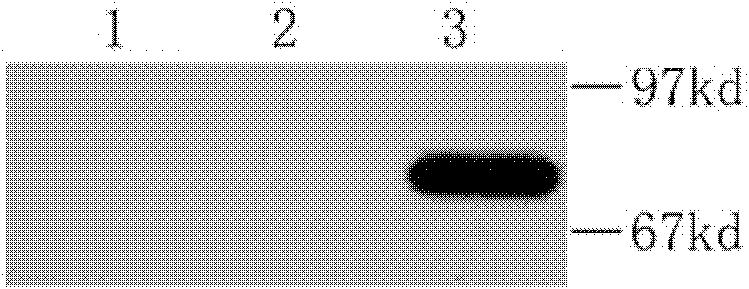Method for efficiently expressing foreign protein
An exogenous protein and protein technology, which is applied in the direction of peptide preparation methods, chemical instruments and methods, botanical equipment and methods, etc., can solve the complex interaction of genes, the uncertainty of exogenous gene insertion sites, and analysis and detection methods Difficult to accurately evaluate and other problems, to achieve the effect of high protein purity
- Summary
- Abstract
- Description
- Claims
- Application Information
AI Technical Summary
Problems solved by technology
Method used
Image
Examples
Embodiment 1
[0053] Embodiment 1, the construction of recombinant expression vector and recombinant Agrobacterium
[0054] 1. Construction of recombinant expression vector
[0055] 1. Using Arabidopsis cDNA as a template, PCR amplification is performed with a primer pair composed of F1 and R1 to obtain a PCR amplification product.
[0056] F1: 5'-TCCCCCGGGATGGAGGATCCTGATATCAAGA-3';
[0057] R1: 5'-GGCGAGCTCTCATATTGGCTCCTTCAGGACTC-3'.
[0058] PCR amplification program: pre-denaturation at 95°C for 5 min; denaturation at 95°C for 30 s, annealing at 60°C for 30 s, extension at 72°C for 2 min, a total of 25 cycles; extension at 72°C for 10 min.
[0059] 2. Digest the PCR amplification product of step 1 with restriction endonucleases SmalI and SacI, and recover the digested product.
[0060] 3. Digest the pMYC2 vector in step 2 with restriction enzymes SmalI and SacI, and recover the linearized vector backbone (about 11 kbp).
[0061] 4. Ligate the digested product of step 2 and the carrie...
Embodiment 2
[0069] Example 2, Preparation and purification of COI1 protein (determination of protein expression)
[0070] 1. Tobacco cultivation before transformation
[0071] 1. Spread the seeds of Nicotiana benthamiana on MS medium, and after vernalization at 4°C for 3 days in the dark, place them in the plant room for cultivation (22°C; 16 hours of light, 8 hours of darkness) until the seedlings grow two leaves (7- 10 days).
[0072] 2. Transplant the seedlings in mixed soil (vermiculite: black soil is 1:1; mass ratio), pour enough water, and continue to cultivate (28°C; 16 hours of light, 8 hours of darkness) for 3 weeks (2-3 weeks can be ).
[0073] 2. Cultivation of recombinant Agrobacterium before transformation
[0074] 1. Put 1 ml of the recombinant Agrobacterium liquid obtained in step 2 of Example 1 into a 1.5 ml EP tube, centrifuge at 20° C. at 4000 g for 5 min, and collect the bacteria.
[0075] 2. Infect the injection with 500 μl (composed of solute and water; solute and...
Embodiment 3
[0094] Preparation and purification of embodiment 3, COI1 protein (determination of the optimal transformation time of leaves)
[0095] 1. Tobacco cultivation before transformation
[0096] Same as Step 1 of Example 2.
[0097] 2. Cultivation of recombinant Agrobacterium before transformation
[0098] Same as Step 2 of Example 2.
[0099] 3. Transformation of tobacco with recombinant Agrobacterium
[0100] On the different leaves of the same tobacco seedling obtained in step 1 (the old leaves are the leaves of 44 days of growth; the middle leaves are the leaves of 38 days of growth; the new leaves are the leaves of 32 days of growth) and inject the recombinant Agrobacterium bacterium liquid obtained in step 2 respectively , each leaf was injected with 300 μl, the timing was started after the bacterial solution was injected, and each leaf treated with injection was taken after 69 hours.
[0101] 4. Extraction of COI1 protein
[0102] Same as Step 4 of Example 2.
[0103] 5....
PUM
 Login to View More
Login to View More Abstract
Description
Claims
Application Information
 Login to View More
Login to View More - R&D
- Intellectual Property
- Life Sciences
- Materials
- Tech Scout
- Unparalleled Data Quality
- Higher Quality Content
- 60% Fewer Hallucinations
Browse by: Latest US Patents, China's latest patents, Technical Efficacy Thesaurus, Application Domain, Technology Topic, Popular Technical Reports.
© 2025 PatSnap. All rights reserved.Legal|Privacy policy|Modern Slavery Act Transparency Statement|Sitemap|About US| Contact US: help@patsnap.com



